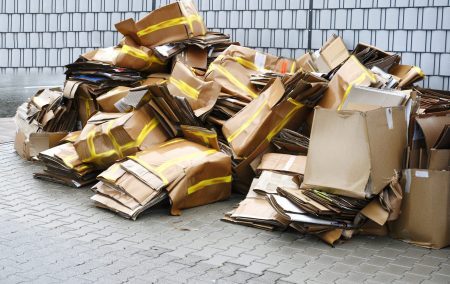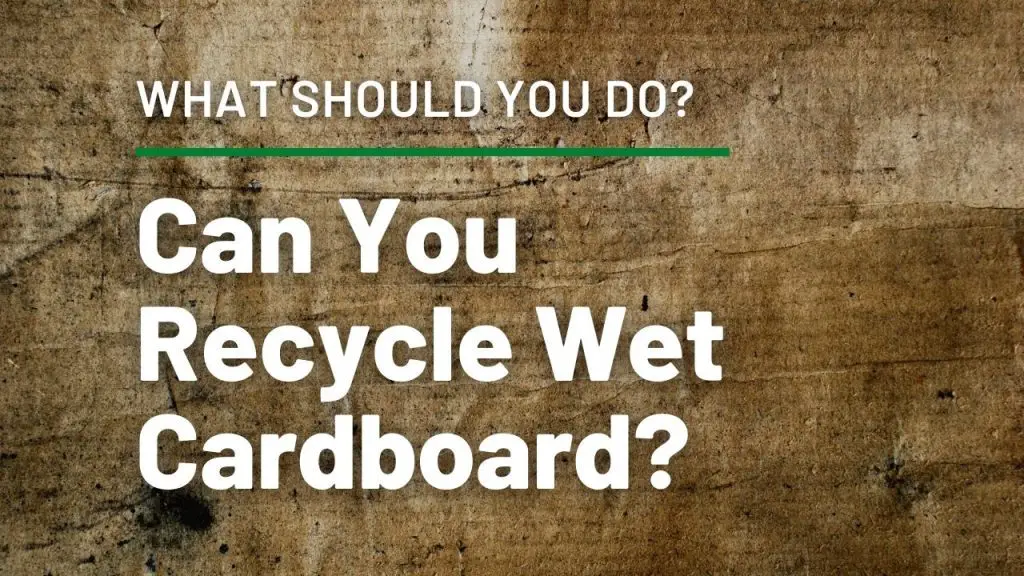As we all know, cardboard is very recyclable. It is a specific product to recycle, and everybody should be doing it. After all, in most towns and cities, cardboard can easily be picked up at the side of the road. We aren’t going to be talking about ordinary cardboard here, though. Instead, we will discuss what happens if the cardboard is wet.
As a general rule, wet cardboard cannot be recycled. It interferes with many steps of the recycling process. If you have wet cardboard to recycle, you should allow it to completely dry out before you bring it to the recycling center or put it in your curbside bin.
Is It Okay to Recycle Wet Cardboard?
Cardboard isn’t just suddenly non-recyclable when it gets a little bit wet. Things don’t work like that. It just becomes a whole lot more challenging to recycle. In fact, due to the increased difficulty in recycling wet cardboard, most recycling centers will refuse to accept it.
There are two main reasons why wet cardboard becomes a lot more challenging to handle for recycling centers.
First and foremost, wet cardboard has been known to clog up their machines. Even a tiny piece could completely shut down the recycling line for a long while. It is a hassle for just about everybody involved.
Does Cardboard Absorb Water?
Cardboard absorbs water as it’s made of paper. To make cardboard waterproof, wax or some other coating must be applied to the outside.
Secondly, wet cardboard will not easily separate from the rest of the recycling. This is due to how recycling works.
Usually, items in recycling will be separated based on how heavy they are. So, as things travel down the recycling line, they will be automatically shaken upon a conveyer belt. Lighter items like paper and cards will be separated from everything else.

However, if the cardboard is wet, it won’t be separated. This is because it is heavier. As a result, it ends up in the wrong box for recycling. Again, this is something that is going to cause a whole lot of issues.
Some indicators indicate that wet cardboard can also be tough to recycle correctly. This is because the fibers inside the cardboard will change a little bit.
This means that the machines will have more difficulty breaking it down. However, the main reasons you should avoid wet recycling cardboard are the two mentioned previously.
If this wasn’t enough, wet cardboard could be incredibly heavy. This makes it difficult for people to carry.
It also increases the risk of the bags tearing when the cardboard is added. Again, these are even more issues you must worry about.
Does Home Depot Recycle Cardboard?
Home Depot recycles cardboard as part of its extensive recycling program. The recycled material is then used to make their moving boxes. To date, Home Depot has recycled more than 1,000,000 tons of cardboard.
How Can You Prepare Wet Cardboard for Recycling?
Now, most people would recommend that you put wet cardboard in the standard trash. However, you can recycle it with a little bit of preparation.
What does this mean? Well, you will need to let your cardboard dry out before adding it to your recycling. This is something that is going to be easier said than done. If you have thick cardboard that is drenched, then it may take over a week to dry. However, if you want to recycle it, you have no choice.
Under no circumstances should you allow wet cardboard to enter your recycling. As we said before, this will end up causing problems for the recycling company.
In an ideal world, the cardboard wouldn’t be allowed to get wet in the first place. So, if you know the exact day your recycling is being collected, keep the cardboard indoors until that day. Only put it out a few hours before the recycling comes.
Don’t put it out if it is raining or it looks like it will rain. Instead, take the cardboard to the recycling center yourself. Sure, doing this will be a little extra hassle, but trust us, the recycling center will love you if you go to considerable lengths to ensure that you are not giving them wet cardboard!
If you have no choice but to leave the cardboard outside, ensure it is well-protected. Wrap it up in a biodegradable bag, or at least cover it with a tarp of some kind. The more protection you give it, the less chance it has of getting wet.
Are Cardboard Boxes Toxic?
Cardboard boxes do contain toxic materials making them unhealthy. They have pollutants like styrene, formaldehyde, and mineral oils that survive recycling. These chemicals can cause respiratory problems such as asthma, bronchitis, and skin irritation.
What If the Cardboard is Dirty?
So, what about if your cardboard is dirty as opposed to wet?
For the most part, it can be recycled. However, if the wetness has caused mold to grow on the cardboard, it becomes unrecyclable. As a result, you will have no choice but to put it into your standard trash.
In addition to this, the cardboard cannot be put in the trash if it has grease stains on it. At this point, it is also almost impossible to recycle.
Dangers of Wet Cardboard in the Recycling Process
Wet cardboard poses a significant threat to the recycling process. When introduced into the system, it can contaminate other recyclable materials and potentially disrupt the operation of recycling facility equipment.
The moisture present in wet cardboard can facilitate the growth of mold and bacteria, leading to the degradation and decomposition of the material. This can create unpleasant odors and potentially harmful fumes, posing a hazard to workers at the recycling facility.
Furthermore, wet cardboard is significantly heavier than dry cardboard, which can cause issues with the sorting and processing equipment used in the recycling process. The added weight can strain conveyor belts and sorting machines, potentially leading to breakdowns and costly repairs. Additionally, the excess moisture can seep into and damage electronic components, further complicating the recycling process.
Overall, it is crucial to keep wet cardboard out of the recycling stream to ensure the efficiency and safety of the recycling process. Properly disposing of wet cardboard can prevent these dangers and ensure that the material is properly recycled and repurposed.
Can You Put Wet Cardboard in the Standard Trash?
You can. This is where most people will end up putting their wet cardboard. However, we urge you to avoid this if you absolutely can.
We know that most people probably do not want wet cardboard sticking around their homes for weeks, which is perfectly understandable. However, if you have space in your home, please do it.
The last thing we want to do is fill up landfills with something that could be recycled. Not only will this be bad for the environment where the wet cardboard ends up going, but it will also be awful because it increases the demand for cardboard producers to make more cardboard. This is also awful for the environment.
Conclusion
In conclusion, it is important to avoid recycling wet cardboard as it can cause problems in the recycling process. Wet cardboard can clog up machines and be difficult to separate from other materials, leading to costly disruptions and damage to equipment.
To ensure that your cardboard is properly recycled, allowing it to dry out before adding it to your recycling bin or bringing it to a recycling center is essential. Properly disposing of wet cardboard will help maximize the recycling process’s efficiency and sustainability while minimizing costs and potential hazards.


I appreciate your warning when you told us that it’s dangerous to recycle wet cardboard since it can contaminate other recyclable materials while also potentially disrupting the recycling process. My relative living overseas sent us a lot of parcels recently, so we ended up hoarding a lot of cardboard boxes because of all the deliveries. I’ll keep this in mind while I look for a recycling center nearby that accepts corrugated boxes.